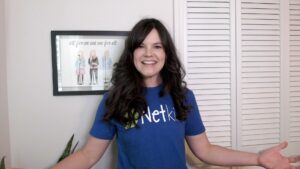The Behavior Tactics That Build Trust Faster Online – With Your Audience and Yourself.
When someone comes to your website, you’ve got less than 5 seconds to identify that they have a problem and convince them you can solve it. A huge part of that is building trust and credibility as fast as possible. I’ve spent hours pouring over the research to figure out how to make that happen as fast as possible. Below, I’ve detailed the fastest ways to build trust and credibility online, with an audience who has never met you.
Use Your Body to Build Trust Quickly
Since building trust is one of the best ways to increase interaction and ultimately conversions, I’ve jumped straight down the behavioral and neurological research rabbit hole. Which brought me to more about building trust, rapport, and credibility with body postures. Let’s translate into how to apply these body tactics on your website.
That’s probably why you’re here. I do the nerd stuff. You use the nerd stuff. 🤓
So, back to the research. The main theme that runs through most of the “truth-telling” postures is exposure of places that could be used to 1. end your life – think the jugular, 2. end your legacy – think reproductive organs, and 3. places to hide things that could end the other person’s life or legacy. If you expose any place that literally makes you more vulnerable, in a split second, you become more believable. (We’ll talk more about the figurative side of this next week.)
Quick note before moving forward – I’m not advocating getting naked on your website…just in case there was any confusion!
So, if we’re not getting naked (awkward 😬 ), what does this credibility-building exposure look like?
Building Trust Body Posture Checklist
- open palms – see? nothing to hide here…;

Welcome!
- more space between the fingers – signals more confidence in what you’re saying;
- wrists toward the viewer – exposure of the radial artery;
- no covering your abdomen – especially for women, as covering this area is a sign of protecting reproductive organs;
- keeping your elbows slightly away from your torso – this exposes the brachial artery;
- no hands to chest or obscuring the neck – carotid artery and jugular vein;
- don’t tuck chin to the chest – carotid and jugular again;
- no hands in your lap resting over or covering the pelvic area – covering this area is also sign of protecting reproductive organs – especially for men.
Quick aside – Did you know that slashing the brachial artery under your arm results in unconsciousness in just 15 seconds and death in as little as 90 seconds? Talk about vulnerability in exposure…
That and plenty of other goodies can be found in this cool article about the dangers of slashing.
You might be saying, “Don’t make it awkward, Tina.” And let’s get real. If I had a dollar for every time I heard that…well, let’s just say I’d probably have a Mai Tai in my hand right now instead of writing this article.😉
But back to reality…If the vision I’ve just painted looks and feels awkward, that’s okay. We’re just human beings. We’re not robots, and if you feel awkward in a certain gesture, you’re going to look awkward.
Practical Tips to Use Body Postures to Build Trust Online
So, I want to share three practical tips with you to make this information useable without making it awkward.

Smiling, looking at the camera, space between arms and body, exposure of neck, mouth partially open
- Use what you’ve got.
This list of how you should and should not pose yourself (and others) on your website can feel overwhelming. So, let’s make it easier. Get the checklist out, and then take a look at the photos you have available to use on your website. Then, instead of putting together an entirely new photoshoot, choose the photos that are naturally ticking the most boxes in the list. - Practice with Intention.
Now this one might sound goofy. But I’m going to come back to it in an email in a couple of weeks because there’s just too much great research to share in one email! But give it a try, and I would LOVE to know how it goes. - Stand in front of a mirror and practice postures listed above to gain some comfort with them. You’re absolutely going to make yourself laugh going through some of these. But I think you’ll land on some postures that feel comfortable AND apply the principles above. And if you don’t feel comfortable, just remember that doing things uncomfortably sometimes ends up making you feel comfortable. But more about that later.
- Change your mind.
It only looks awkward if you think it’s awkward. When you stand in front of the mirror practicing, find a couple of positions that don’t feel completely awkward and then say to yourself, “you look so trustworthy,” again and again. Your mind will eventually follow…as long as it’s not a complete lie…but again, that’s a topic for another day.
Application on Your Website
I like to put together applicable tips you can use on your website. But this checklist is also great for quickly building trust in presentations, sales meetings, and…you guessed it…dating.

Compare this to the earlier version. Which is more welcoming and likable? The first! Why? My mouth is slightly closed here. There are no smile wrinkles around my eyes. You can’t see the space between my legs. This photo is okay, but the first one is better for building trust.
Let’s take a quick look at a couple of bio photos I could use (pictured above and below).

Full smile in this one, wrinkling around the eyes. This photo is ok, but it’s still not as good as the first. Why? No eye contact. The eye aversion in this gives the feeling that I’m embarrassed vs confident. And you can’t really see the space between right arm and body or my legs. Chin is also slightly down, covering a bit of my neck. Instinctively, in a side by side comparison, the first photo gives the viewer more of a feeling of looking at someone who is confident and trustworthy.
One take away for you today
Take a quick peek at your website. If you see any photos that are missing the mark in several of the areas on the credibility building checklist above, do three quick things.
a. make a quick change,
b. make a note of the date, and
c. see what happens.
It might feel like I’m droning on about poses for website photos. But here’s the thing. On our websites, we only have seconds to capture attention and gain enough trust from our audience to get permission from their brain to extend that time. My goal is to find better and better ways to gain nearly instant trust, so the message you’ve worked so hard to put together has a chance to work for you.
Build Trust and Credibility for the Long-Term
As I’ve been looking into building trust faster, I’ve also been thinking about the underlying elements that say trustworthy without saying trustworthy – vulnerability and transparency. Trustworthy body language is about using visual cues to literally be vulnerable and transparent with your audience.
Learning to Build Trust From Spies Among Us
Which brings me to building long-term credibility and trust. I was recently watching someone interview Jack Barsky, a former KGB Spy who is now an American citizen. He was embedded in the US for about 10 years as a KGB operative before the FBI flipped him to begin working for the US. He said in the spy business it’s always difficult to maintain credibility with your employer, especially if you’re embedded in another country.
Not only are you practicing duplicity for a living, but you’re also immersing yourself and “pretending” to be part of something else.
Below we’ll talk about what pretending does to your body and mind.
Jack said the one thing that helped him maintain credibility during his KGB tenure was exposing his own gaffes. Things the Russian government likely never would have found out if he kept them to himself. Because he volunteered his missteps on several occasions, the Russian government trusted him even more. Being open with his mistakes communicated loyalty to the KGB.
There was an FBI counterintelligence agent on the same interview with Barsky, and his response to Barsky’s statement in the interview was, “Transparency goes a long way for building trust.”
Even the spies among us assign a high value to transparency and vulnerability when building and maintaining trust.
You can watch the full spy interview here.
Great Reminder
I’m not talking about anything new here. But it’s a great reminder that these practices of voluntary vulnerability and transparency cross the most interesting industry lines.
Voluntarily exposing where we are most vulnerable or what might cause us the most harm builds trust faster. Whether in body or in deed.
The visual cues of a body can create a feeling of credibility, but we all know the interest in what we have to offer peters out unless that trust and credibility have continued substance behind them. And each interaction either reinforces that credibility or undermines it.
I want to help you capture attention quickly on your website. I want to help your message engage your audience as quickly as possible. AND I want you to take advantage of every opportunity to confirm the initial impression you create. Because people buy from people they know, like, and trust.
Continued practice of vulnerability and transparency can lead us to all three – faster.
Let’s Pretend to Build Trust
Now let’s turn to ourselves and talk about what pretending does to our brains. For the TL/DR: pretending tricks the brain into reality.
Skip to the “Keeping it Actionable” section below if you’re not interested in the research.
For the nerds 🤓 among us, here’s how we know this works…
Some Research. Some Practice.
Behavior Performers
I heard behavioral performance specialist Mark Bowden say the other day, “The body leads the mind.” Mark trains people to speak and act publicly in really high stakes situations. I’m talking, he trains the leaders of the G7. Very high stakes.
And he often tells his clients that if they want to feel something, they need to act it out with their body first. And that’s what he means by, “the body leads the mind.”
Neuroscientists
Mark knows this from experience, but guess what? Neuroscience backs him up. If you want to learn more about how this works in the brain, check out Dr Andrew Huberman’s podcast, The Huberman Lab. Dr Huberman is a neuroscientist at Stanford, and his podcast aims to make neuroscience understandable and practical for the layperson.
He says using the mind to control the mind is self-defeating. But using the body to control the mind is much more effective. And then he walks you through how to control the chemicals that regulate your behavior. It’s absolutely fascinating. And I’ve included some of his advice in the actionable section below.
Psychologists
Dr Huberman’s podcast is relatively new, but Dr Milton Erickson, a renowned psychotherapist from the early 1900s conducted many studies on hypnosis. In some of his earliest experiments he had subjects pretend to be hypnotized to see how they might “act” the process out differently from those who were truly hypnotized, in this case meaning somnambulistic. In the majority of the studies, conducted over decades, when someone pretended to be hypnotized, they ended up actually hypnotized.
Yes, somnambulistic – sleepwalking.
You can read more about this research in a collection of his papers called “The Nature of Hypnosis and Suggestion.”
More recently, Dr Jordan B Peterson, of Harvard University and University of Toronto fame, has written a book called 12 Rules for Life. This book comes from his years of research in the work of Freud, Carl Jung and then human and animal behavior.
His first rule is to “Stand up Straight with Your Shoulders Back.” This particular rule comes from studies in lobsters that prove to have striking parallels with human behavior. When lobsters (or people) feel defeated, they slump. Head down. Shoulders hunched.
When humans adjust their posture to one of confidence – standing up straight with shoulders back – they start feeling like they can try again.
I could pull in more and more research from different scientific practices that all agree.
You can use your body to exert control over what’s happening in your mind.
But I think we’ve intuitively known this for millennia. Our spiritual practices have included body over mind from yogic breathing to physically putting on the armor of God.
And now, let’s get practical. Because fascinating as it is to understand the research, it’s not really that helpful if we can’t use it.
So first things first, let’s talk about how this can work for you.
Skip down to see how you can use movement with your website audience, learning from some top notch military interrogators and trial consultants.
Keeping Pretending Actionable
Most successful people will admit that along their journey, they’ve had impostor syndrome. Sometimes even after they’ve established a track record of success.
And let’s be really candid, if you don’t believe what you’re selling, why would anyone else buy it? So, while we’ve talked about building trust and confidence with your audience, it’s also important to build it within yourself.
You must believe in what you offer your clients in order to turn that into a successful business. And for many of us, what you offer is YOU!
So, to make this actionable, let’s go back to Mark Bowden’s suggestion to use our body to prompt our own belief.
The 6 Tips to Build Trust With Yourself
Use these while interacting with your audience, to take control of your mind.
- Feeling tired or unsure? Stand up straight with your shoulders back. Ears over shoulders over hips. Not only does this allow you to feel more confident in yourself, it’s also great for aches and pains we experience from sitting too long, working on a keyboard all day.
- If you’re feeling off-balance, unfocused, or unsure: Use symmetrical movements. Both hands or arms at the same time while speaking. Feet shoulder width apart, weight evenly distributed, if standing. Feet firmly on the ground if sitting. Mark Bowden says using both arms at the same time serves as blinkers (on horses, not car blinkers), to keep us focused on what’s in front of us. Not distracted by things that could go wrong.
- Feeling nervous or timid about what you’re communicating: Pull your arms up to waist height. Give yourself space between your arms and torso. Expose both hands, palms and wrists to the audience. This communicates confidence to viewers while reassuring yourself. You can even try this in the mirror if you need to give yourself a pep talk.
- If you’re tired, energy lagging: Use the Wimhof breathing method to increase your energy and heart rate. This kind of breathing triggers excitement chemicals in your nervous system.
- If your heart is beating too fast: Take two back-to-back inhales, followed by a long exhale. (Dr. Andrew Huberman demonstrates this here and talks you through why that works.) Repeat this a few times. This type of breathing offloads carbon dioxide quickly and calms us.
- And finally, give yourself a pep talk. Yes, positive self-talk works. BUT…Dr. Huberman shares it must be a) something you can really believe AND b) something that is likely to become reality quickly.
Make it Believable
In other words, you need to state a small believable win that is highly likely to happen and will be in the direction of your ultimate goal. As an example, if your revenue is off by $10,000 this month, you cannot simply tell yourself that you have that money in the bank. That’s not believable.Instead, remind yourself of how you’ve previously been able to generate that level of cash. And that you have every ability to do it again. And this step you’re about to take, will move you closer to making that happen.If what you’re telling yourself is credible, the positive self-talk will work.
I would LOVE for you to test some of these tactics out this week. Just to see if you find it believable that your physical actions can lead your mind in the direction you want it to go.
And here’s why…
Well, first, I just think it will make your life better. To grasp how much power you have over your own mind and behavior.
But also, because next, I want to talk about how we can help your audience to use their body to direct their mind, when they’re on your website.
Movement facilitates openness in your audience.
Every great sales person knows if you can get someone to open their posture to you during a conversation, they’ll be more open to doing business with you.
But what do you say to make that happen? “Hey, can you open your arms while we’re talking? I just feel more comfortable when people open their arms.” 😳
Yeah, probably not.
Here’s a witness stand technique used by big trial consultants. If there’s a high stakes question for a witness in a deposition or while they’re on the stand, and the lawyer wants an honest answer OR wants the witness to be open to what they’re asking, here’s what you might hear. “Would you mind adjusting your mic so we can hear you better?”
Three Reasons Movement Works
- The act of the witness reaching for the mic usually ends up with more open body language.
- You’ve got them moving forward.
- They’ve said yes to something you’ve asked.
There’s a LOT of power in that first yes. Just ask Dr. Robert Cialdini.
Dr. Robert Cialdini writes about this concept in his book, Influence. Getting someone to say yes to a little thing makes it more likely they’ll say yes to a bigger question.
Having them agree to move is a little “yes” in your direction.
If you can get your audience to move, you’re using two methods to make It easier to do business with you. 1. It’s a little yes. 2. It opens their body language, which opens their mind to what you’re offering.
So, what does that look like IRL, on a website?
There might be a paragraph on the website that starts like this…
“This might feel awkward, but do this quick exercise with me. Plant your feet firmly on the floor. Hands resting on your legs. Take a deep breath. Now imagine your life one year from now…Really, take a minute and do it. I’ll be right here when you’re finished.”
This is not only getting a small yes and opening body language, but it’s also future-pacing your audience and helping them see what life could look like after working with you. You’ve probably seen this in email campaigns. (Amy Porterfield is the queen of future-pacing, simple yeses, and audience action.)
OR
One of my favorites is from Dr. Nancy Trimboli with Trimboii Chiropractic. Her chiropractic team helps people move from pain and negative environments to health and positivity. She says, “Think of the thing in your life that is most distressing to you right now. Picture it written out in front of you. Now take your fingers, hold them out in front of you and swipe it left out of the air.”
This one is almost sure to get participation.
But Where to Put it…
You might be looking at the length of copy there and wondering…”where in the world will I put that much copy on my website?” There are a few sections I would suggest as a start.
- Your Bio – yes, this is where you talk about yourself and your background. It’s also the perfect opportunity to use some of the copy to walk your audience from a problem to success. You can reference your own journey, or you can reference the journey of others you’ve helped. Either way, this not only builds credibility in you as the guide, but it also puts the audience in the action of the story.
- Explanatory Paragraph – This is StoryBrand language. (Click the link if you’re curious about what StoryBrand is.) And it’s a paragraph that takes your audience through what they really want from you, the problem they’re facing to get there, the steps they can take to overcome it, why you’re the right guide to lead them to success, and what it will cost them if they don’t do business with you, and what their life can look like if they do. Perfect place to have them literally move from problem to success.
- The Cost Section – I don’t mean pricing here. This is a section where you define what someone will lose if they don’t make a decision to do business with you. If that sounds icky, don’t worry, it’s not all doom and gloom. This section should end with a hope and a promise of a better future.
Not sure how to incorporate any of these sections into your website? Take a look at our website templates here. They have each section you need to take the StoryBrand framework and make it a reality on your website.
Definitely get creative here. These are not the only ways or the only places to incorporate movement from your audience. The key is to get them moving. Saying yes to what you’re suggesting. If they follow, that’s a sure sign that you’re building trust and credibility.
Doing business with you won’t be far behind.

